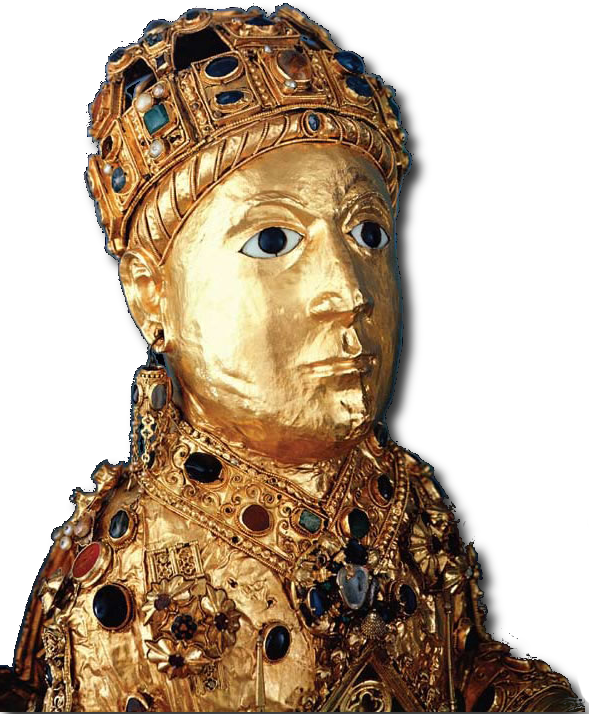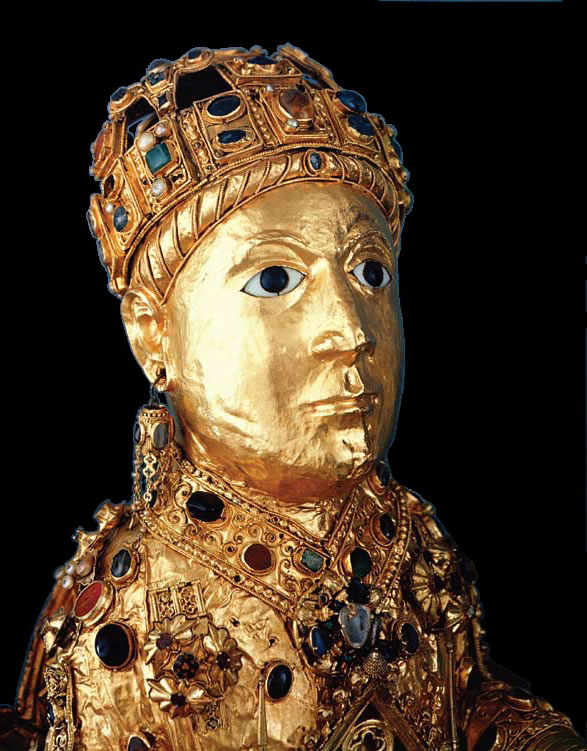 |
MedievalEuropeOnline
the web home of Medieval Europe: A
Short History
|
The Cover: Everything you ever wanted to know.

In brief . . . The cover shows a reliquary that contains relics of Saint Foy.
At greater length . . .
What is a reliquary? A reliquary is a container built to hold a relic or relics. Early reliquaries were boxy, but they later began to take the shape of the relic. So, for example, a relic of an arm would be housed in a reliquary shaped like an arm. You can see some reliquaries and read more here.
What is a relic? A relic is an object venerated because of its association with a saint or other religious figure. Examples would be: pieces of the holy cross on which Jesus was crucified; the chemise of the Blessed Virgin Mary; the head of Saint John the Baptist. Click here for the modern teaching of the Catholic Church on relics.
Why did relics matter? Relics were credited by medieval people with healing powers. So, for example, Saint Foy’s specialty was healing blind people and freeing prisoners. If you had lived in France and suffered from poor sight, you would have made a pilgrimage to Saint Foy’s shrine; once there, you would have prayed and left goods or cash; then, you would have hoped that she would reciprocate by interceding with God to improve your vision.
Who is Saint Foy? Well, first, she is also called Saint Faith. She is one of many virgin martyrs revered by medieval people, and she was thought to have been killed by a Roman emperor in the fourth century (the traditional date is 303 CE). She had lived in the town of Agen in southern Gaul (or France), and her relics were kept there. By 866, the monks of the monastery at Conques had acquired the relics, perhaps by stealing them. Why? They wanted to built a shrine to her and use it to attract pilgrims. Why? Pilgrims were good business. From that time on, lots of stories circulated about miracles at her shrine, and she became a very popular saint.
So, this reliquary of Saint Foy? What you see on the textbook is the head of a larger figure. It was made in the ninth century, although it was changed a bit later. It has a wooden core covered with gilded silver, copper, enamel, precious stones, and cameos. If you look closely, you’ll see she is even wearing earrings. The head is disproportionately large, and some art historians think it was borrowed from an effigy of a late Roman emperor. On the back of the head is a receptacle for Saint Foy's skull. It is still there, encased in silver. (Her other bones were buried beneath the altar at Conques.)
Want more? If you would like to read more about Saint Foy, start here: Kathleen Ashley and Pamela Sheingorn, Writing Faith: Text, Sign, and History in the Miracles of Sainte Foy. Here’s a link that will let you peek inside.